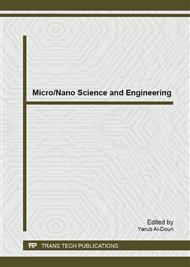p.580
p.585
p.590
p.595
p.600
p.605
p.610
p.614
p.619
Efficiency Enhancement in Dye-Sensitized Solar Cell Using TiO2 /Ilmenite-Derived Nanofiber Composite as Working Electrode
Abstract:
TiO2 nanocomposite films of calcined TiO2 nanofibers and commercial-grade TiO2 nanoparticles Degussa (P25) utilized as working electrode of dye-sensitized solar cells (DSSCs) are prepared by a doctor blade method. TiO2 nanofibers were synthesized from ilmenite mineral by hydrothermal process in combination with calcinations process. The prepared samples are characterized by XRD, XPS and TEM. The photoelectric conversion performance of the DSSC based on nanocomposite film electrode was compared to the device fabricated by pure P25 at the same film thickness. The result shows that as calcination temperature increases, the transformation of nanofibers to nanorods and nanoparticles were observed. The energy conversion efficiency (ƞ) of the device tends to with increasing calcined temperature. The greatest ƞ is 3.90% obtained from DSSC fabricated from nanocomposite film electrode of 5 wt.% nanofibers calcined at 800 oC for 2 h mixed with P25, indicating the significant enhancement in its performance by the incorporation of the nanofibers. This enhancement of DSSCs may correlate to high surface area, higher light scattering and light harvesting, low charge recombination and fast electron-transfer rate by nanofibers.
Info:
Periodical:
Pages:
600-604
Citation:
Online since:
April 2014
Keywords:
Price:
Сopyright:
© 2014 Trans Tech Publications Ltd. All Rights Reserved
Share:
Citation:



